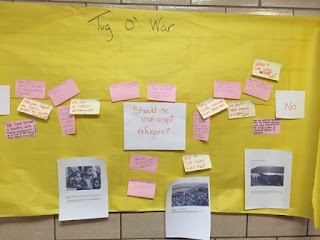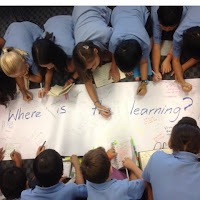Making Thinking Visible
It is no great news that children are created in a myriad of different ways and the way they synthesise things is as varied. We have the listeners, the visual learners, the kinesthetic and the cognitive to throw out a few of the technical terms. Our challenge is not only to cater to all of those varying forms of learning but also to be aware of who our different learners are within our classroom.
By making thinking visible, it helps us, as their educators, to see exactly what is going on ( or not going on in some cases) as each child is learning and to facilitate their learning further. Also, for a child to be able to show their thinking and explain how they came up with a solution, is a big confidence booster! :
Perspective: Tug O’ War
The Tug O’ War is an amazing provocation and converstation starter and will certainly get the children thinking about the key concept of perspective. Using pictures or text and a question to ponder, the children will write their opinion to the question on a sticky note and post it on a continuum of yes at one end and no at the other end. This can be done anonymously or not. I have used the technique along the lines of a gallery walk, with my 5th graders, where they look at the other answers and note their thinking. We then come together as a whole class to discuss the different perspectives. It is perfectly okay for the children to change their thinking with an explanation and to move their sticky note.
Connection: Interactive Organisers
 Making connections is a thinking skill that goes on all the time within all subject areas. By using large graphic organisers, the children are able to work together cooperatively, sharing and building upon their thinking. They have to use a ton of discussion as they work to place their thoughts. The concept maps that I often use within our inquiries are a great way to SEE how the children are making connections between the key concepts and their vocabulary or math skills or whatever you may be working on. You can check out concept maps here from a previous post.
Making connections is a thinking skill that goes on all the time within all subject areas. By using large graphic organisers, the children are able to work together cooperatively, sharing and building upon their thinking. They have to use a ton of discussion as they work to place their thoughts. The concept maps that I often use within our inquiries are a great way to SEE how the children are making connections between the key concepts and their vocabulary or math skills or whatever you may be working on. You can check out concept maps here from a previous post.Reflection: The picture below shows a formative assessment that I did towards the end of our unit of inquiry. But of course this can be done with any curricular area. I’m planning on trying it with our math unit of fractions too.



